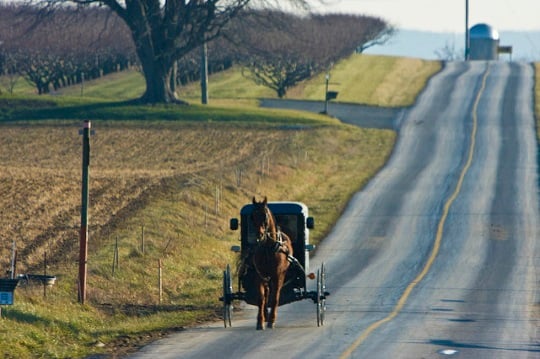4 Reasons Why Amish Stay Healthy in Old Age

TIME Magazine has a new article called “Amish People Stay Healthy in Old Age. Here’s Their Secret.” It starts with some interesting info I’d never seen before:
The average American life expectancy is currently just under 79 years. Back in 1900, it was only 47, but for early–20th century Amish it was already greater than 70.
I don’t know the source of this, but let’s take it at face value. Maybe there were lifestyle differences that were more extreme in the 1900s than they are today. Or some other reason I’m not considering.
We then learn that while overall life expectancy between Amish and non-Amish today are similar, the Amish today have certain advantages that make them healthier in old age. These lead to lower disease rates – including for cancer and diabetes.
Why is this the case? TIME presents four main reasons. I’ve summarized them here:
1. Active lifestyle – More walking and manual labor means lower rates of obesity and Type 2 diabetes. A study found Amish to be six times as active as a random sample of individuals from 12 countries.
2. Low tobacco use – Tobacco usage rates have been found to be lower among Amish. A study in Ohio found this translated to a 63% lower rate of tobacco-related cancers. The study also showed an overall 40% lower cancer rate compared to the non-Amish population in the state.
3. Genetic advantages – Last autumn we saw the remarkable story of the Amish gene mutation found in an Indiana community. Amish with the mutation of gene PAI-1 have both a longer life span, and a longer “health span” – with markedly less diabetes and lower vascular age.
4. Aging in place – This is another cultural factor – the fact that nearly all elderly Amish people are cared for at home makes a big difference in health. This is called “aging in place,” with one study estimating that it “has the same longevity benefits as quitting smoking.”
Caveats?
One caveat that came immediately to mind – “healthy in old age” is a pretty broad statement. Maybe the Amish do better in some areas, but in other health markers not noted in the article, they might be relatively worse off, either owing to genetic or other reasons.
Indeed the article concedes this in at least one area:
Cardiovascular disease is one area in which the Amish don’t have an edge, with blood-pressure and heart-disease rates slightly higher than those of other populations. Some of this might be attributable to the Amish diet, which is heavy on pancakes, eggs and sausage for breakfast; and meat, potatoes, gravy and bread for dinner. Working the farm can burn off those calories, but all the fat and salt and carbs still take a toll.
I can say, eating this diet when visiting Amish friends but doing relatively little manual labor (Amish taxi driving doesn’t count), it takes a toll on my waistline.
 A related point would be that Amish are still eating this heavy farmer’s diet, but proportionally fewer Amish are farming over the past several decades with the move into small businesses.
A related point would be that Amish are still eating this heavy farmer’s diet, but proportionally fewer Amish are farming over the past several decades with the move into small businesses.
While manual labor is still a part of the culture, making furniture or running a store simply doesn’t burn as many calories as running a farm with its steady stream of varied tasks typically needing muscle and sweat. So I wouldn’t be surprised if the overall Amish obesity rate is on the upswing (the weight studies cited above date from 2004 and 2012).
Genes are also a double-edged sword. This is most obvious when we see the sad cases of Amish children stricken with genetic diseases. But perhaps there are other genetic effects within the Amish that take a less drastic but still notable toll on some areas of health later in life.
Another caveat is the fact that there are differences across Amish communities. Smoking is more prevalent in some than in others. The genetic mutation noted above was found only in the Adams County, Indiana settlement.
Benefits for non-Amish?
In any case, three out of four of these factors are things that non-Amish people have some measure of control over. They are things that we intuitively know should contribute to health and well-being, and are theoretically available to us.
For most it’s not realistic to replicate these completely, outside of an Amish context (e.g., if you have an office job lifestyle occupying 8-10 hours of your day, not to mention other tasks, you have to manufacture space for exercise), but to some extent these things can be adopted by non-Amish people.
And if the anti-aging drug being developed based on the Indiana gene mutation pan out, English people may soon benefit from that Amish health edge as well.
Photo credits: Lancaster buggy – Kim Davies/flickr; Buggy at stop sign – jerseygal2009/flickr






The Amish sure beat many others with all their hard labor. One thing I really admire about them is how the younger generation looks after the older folks in their golden years. Living close by but still having their privacy is a big plus too.
Lucky me!
We are so lucky to have the best Amish neighbors-a family of three different homes, built next to each other at the end of our street and surrounded by farmland. Our neighbors are some of the happiest, friendliest people we’ve ever had the pleasure of knowing. They are not just spiritual, they are fun-loving and charitable. Another reason for their longevity, I believe is their fellowship with friends and church members and family – on an ongoing basis. Happiness and laughter brings about healthy endorphins and when they say “laughter is the best medicine” they aren’t kidding. Studies have shown that getting together and socializing on a regular basis is very key to good health. They are so much smarter than the average bear. Love living amongst the Amish!
You are so right.
You are so right Lorraine. I envy the elder Amish because of there closeness to family and friends. With families scattered far and near loneliness permeates the life of most elderly people. Even in our church families being a single elderly woman leaves you alone and not included in a lot of activities.
That sounds great Lorraine. I know a lot of people would like to have Amish neighbors and some even move to Amish communities to have just that. Good point on that fellowship factor, that’s something that’s probably hard to quantify but I’d bet it makes a difference.
Farm Accidents
It is a very interesting conversation to compare the old age health of the Amish against the general population. I did grow up with the Amish and went to school with them in the early school years so I have had some personal experience with them.
I do believe that the Amish farm life has some positives and negatives from a health point of view. Even though the Amish lead a relatively “clean” life from the point of view of consuming the basics from the farm, vegetables, fruits, grains, meat and fowl, I think this diet is as a whole healthy but as mentioned, the Amish in general do not attempt to reduce some “bad” items in the diet, such as fats, sugar, carbohydrates and therefore will get those same high blood pressure, cholesterol, diabetes symptoms as the general population. I do not think that they are vigilant in carefully watching their diet. Some of this danger will be ameliorated by their hard work, and better psychological profile because of the family and group interaction.
But, one area which has not been discussed, is in the area of accidents which may (?) or may not be higher than than that in the general population, but this is a general question where I have not seen any study.
What kind of accidents do the Amish have?
They are very susceptible to Farm Accidents. For example:
1) Plowing fields by hand and using combines where extremities can be caught or injuries can occur.
2) Proximity to farm animals, horses, etc.
3) Driving on highways with horse and buggy and getting hit by automobiles. Happens constantly.
4) Falling through ice, either in play or harvesting ice blocks for the cold storage.
5) Etc.
I would be welcome to review any formal studies which you can quote or provide in this area.
Randy, good question you raised, I have often wondered about this issue myself. We had a post in 2011 called “Is Amish Life More Dangerous?” on this topic. https://amishamerica.com/is-amish-life-more-dangerous/
I’d need to looks a bit closer to see what studies there might be, in the meantime that post and the accompanying discussion might be of interest.
Also, there have been formal attempts to improve farm safety by the Amish in partnership with outside organizations. Here is one example from 2000, where specialists from Penn State helped create a game for Amish children called Amos & Sadie’s Farm: A Pathway to Safety.
http://old.post-gazette.com/regionstate/20000618amish6.asp
Hard to believe
I have a very hard time believing that incredibly low average life span in 1900. I am a little surprised that the amish don’t have a longer life span considering they live in farm areas and don’t pollute themselves with tv but maybe the diet is an issue as well as a stricter lifestyle that may limit activities and ideas that promote health. I don’t know what that drug is that was mentioned but I can’t imagine it working. Sorry.
Life expectancy - 1900
Apparently life expectancy was really right around 47 in 1900, however what most struck me was the discrepancy between the Amish and the general population expectancy. Here are the general life expectancy figures dating to 1900 (page 30 of this doc; the figure given is actually a bit over 49 years, but for the period 1900-1902): https://www.cdc.gov/nchs/data/nvsr/nvsr54/nvsr54_14.pdf
The experimental drug is based on a gene mutation discovered in an Indiana Amish community, which has resulted in its carriers having not only a longer life span but also an extended “health span”. A Japanese company is currently testing it.
More here: https://amishamerica.com/amish-gene-mutation-may-extend-lifespan-by-10-years/
I think I’ll take the optimist perspective and say, well why not? 🙂
If Amish have less cancer etc., but the same lifespan as general population, then...
If Amish have less cancer etc., but the same lifespan as general population, then they must be dying of other things more than the general population, right? I would have thought Amish would live way longer. Make ya wonder…